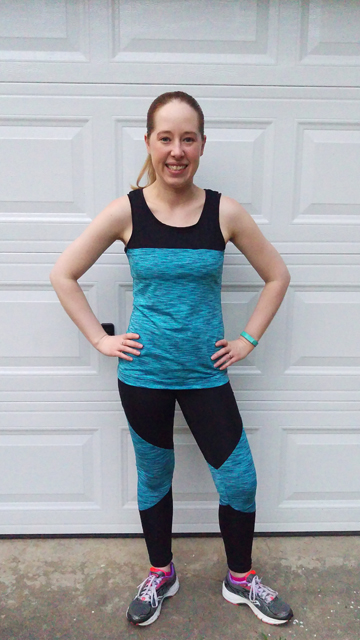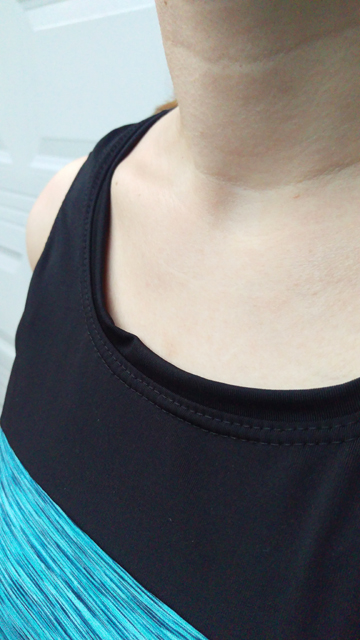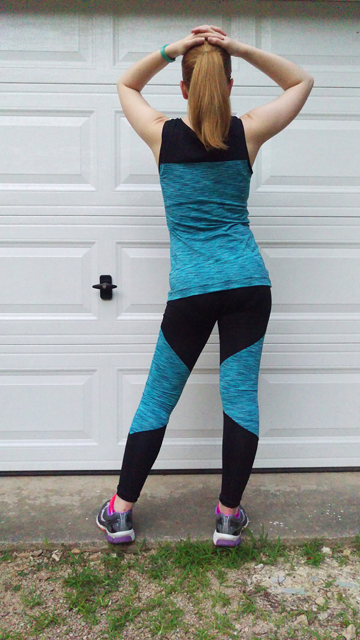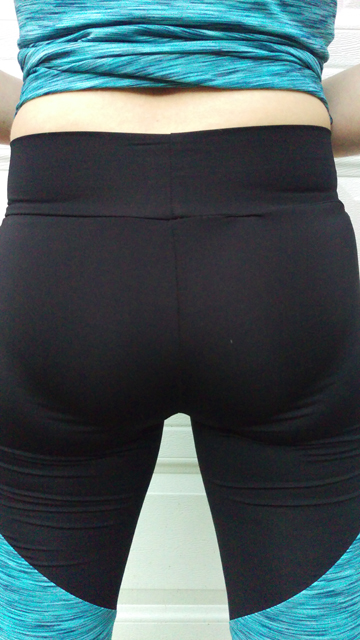For Christmas 2014, Justin encouraged my renewed interest in fitness by gifting me a complete gym kickstarter kit that included a Fitbit, a Camelbak water bottle, and a pair of athletic leggings with matching wicking T-shirt. The clothes, which replaced the ratty cotton-spandex yoga pants and novelty tees I’d worn to the gym all throughout college, were a huge upgrade in terms of comfort and performance. They’re easily in my top 5 most used gifts, and they’ve held up really well over the last year and a half—in fact, they’re still going strong—but they have two drawbacks. First, the leggings are from Under Armour’s ColdGear line, which means they’re lined with microfleece for warmth and thus not the most suitable for spring/summer wear (even though that wear takes place in an air conditioned gym). Second, they’re just one set, which means I have to wash them at least once a week if I don’t want to offend fellow gym-goers with my rank aroma.
I’d been eyeing a few different options from major athletic brands online and crossing my fingers for a sale, until, on a quick trip to JoAnn to pick up some notion or other, I casually spied some pretty space-dyed polyester-spandex described as a quick-drying performance fabric (still available here at the time of writing; don’t trust the color in the shop photo).
I tried to talk myself out of it, but in the process only managed to stumble upon the same fabric in another colorway (also still available here; again, don’t trust the color in the shop photo) as well as a complementary solid black (I believe this is the one). Deciding this was a prime opportunity to vote with my dollars and show JoAnn there’s a market for apparel fabric and specifically athletic fabrics, and also determining that this was probably the one time where it actually would be cheaper to make my own clothes rather than buy them, I brought home a couple of yards of each.
Lightweight leggings and a fitted tank are perfect for the warmer days of spring. The tank top is New Look 6285 View C and the leggings are McCall’s 7261 View D.
Let’s talk about the tank top first, since it was a much more straightforward project.
N6285 isn’t marketed as an athletic pattern, but the basic design works for both my casual wear and exercise needs, and the color-blocking possibilities immediately caught my attention. Coordinating gym separates are something I’ve longed for since my (broke) college days—who doesn’t feel more motivated by a matching gym set? It may not be readily apparent from the envelope art, but View C has an hourglass silhouette while Views A and B are straighter and looser. Since my current gym t-shirt is on the relaxed side, I thought it would be fun to try a more fitted top to see which I prefer.
I cut a straight size 6 based on the finished measurements; a size 8 would probably work just as well, but cling a little less around the stomach. The pattern is drafted with 3/8″ seam allowances, which is perfect for serging. I jumped straight to assembling everything on my serger rather than basting/sewing with a zigzag on my sewing machine first, which resulted in three places where I failed to catch all of the layers. But a little hand-stitching followed by more careful topstitching made those places practically invisible on the finished garment. In fact, I’m pretty pleased with how steady my topstitching came out, even if the neckband is a little wavy.
The top is a little longer than I expected, but the length combined with the negative ease keeps everything anchored nicely around my hips, even when I’m running, so I don’t think I’d shorten it on future versions. The straps also seem a wee bit long: the armscyes don’t quite expose my sports bra, but it’s close, and even though that doesn’t really bother me, I think I’d like to take them up a bit just so the yoke, the widest part of the bust, and the armscyes are sitting where they’re supposed to. I wish I had thought to topstitch the yoke seam, but I’d already sewn everything together by the time the idea occurred to me, so I’ve filed it away for next time.
Now, let’s talk about those leggings. I’d made two pairs of cotton-spandex leggings using McCall’s 6173 View B (unblogged, because they’re vanilla black leggings), so I initially assumed that these athletic leggings would be built from the same block, and that I could simply transfer the minor fit changes I’d made previously to this new, slightly more interesting variation. A quick look at the tissue proved that this was not the case. In fact, I have this sneaking suspicion that the M7261 leggings aren’t designed from a knit block at all, but instead use a woven trouser block. Based on the observations below, see if you agree with me:
- M6173 is sized XS–XL, whereas M7261 is sized 6–22
- M7261 has a completely different front and back crotch curve than M6173
- M6173 is graded such that the sizes are nested with no overlap, whereas M7261 is graded with overlapping size lines
- Most if not all of the reviews on Pattern Review complain that M7261 run large instead of being fitted like one would expect for a pair of leggings
Pretty fishy, right? Luckily, I had the two patterns to compare as well as the reviews to help me choose my base size and modifications. Unfortunately, McCall’s was not about to let me off that easily, as they did not see fit to include the finished waist, hip, or inseam measurement, nor did they mark the location of the hipline. I found myself muttering “Seriously?!” over and over as I tried to line up the pieces to determine the correct size. I cannot for the life of me figure out why none of this information is printed on the envelope, in the instructions, or on the tissue, since ALL of this information was essential to creating the pattern. Surely it’s in a spreadsheet somewhere?
I ultimately chose to make the size 6. Because I’m only 5’2″, I shortened the legs by a total of 4″; to keep the balance of the contrasting sections, I subtracted 2″ at the lengthen/shorten line and another 2″ from a line I drew on the bottom leg piece (specifically, a line drawn at the same distance from the leg seam as the provided length/shorten line is located). Since I’m not a fan of pants that sit at my natural waistline, I lowered the front rise by 1.5″ and the back rise by 1.25″ based on the fit of my RTW running leggings, which sit slightly higher than my regular pants and hit between my natural waist and the top of my hip bones.
Then, I painstakingly reduced the seam allowances of every piece from 5/8″ to 3/8″. Ostensibly this was for ease of serging and because I hate waste, but in reality I might just be some kind of masochist. I’m not sure if I redrew some of the notches in the wrong places, or if I made the mistake of matching edges when I should have been matching notches, but my seam intersections are hit-or-miss.
The verdict on all those fit changes? Good, but not great. As soon as I pulled on the finished leggings I could detect a bit of camel toe happening in the front and a valley forming along the center back seam. It’s not terribly noticeable to others, but I can definitely feel it. The obvious solution will be to copy the crotch curve from my other pairs of McCall’s leggings, which don’t have these issues. The fit is also a little too snug throughout, especially around the bum when I squat/do leg presses, but I think this can be easily solved by tracing off the size 6 with its 5/8″ seam allowances, but sewing them at 3/8″ instead.
A few people on Pattern Review noted that the waistband doesn’t stay put. I didn’t think it would be a problem at first, but when I move around, it definitely has a tendency to roll. I thought maybe it was just a result of using a very light material under too much tension, but after re-inspecting my RTW running leggings, I realized that they do, in fact, have an elastic sewn into the seam at the top of a wide waistband. I’m definitely going to incorporate this feature into my next pair.
The real test, of course, comes from wearing the ensemble for exercise. I’m happy to report that this outfit’s maiden voyage to the gym did not result in any split seams, unexpectedly see-through fabrics, or other forms of abject embarrassment. In fact, although I said the fit was good but not great, a lot of the nit-picky fit issues weren’t that noticeable once I fell into the rhythm of jogging on the treadmill. That’s not to say the issues aren’t worth fixing, but it just goes to show that just because a garment doesn’t bear up under minute scrutiny doesn’t make it unwearable or even all that uncomfortable. And that gets me pretty pumped to sew up another set so that I have more options on gym days.










Were you happy with the quality of the performance/activewear jersey you got at Joann? I bought some grey, and it just felt so flimsy that I ended up not using it.
You’re right that it’s quite thin, but despite my fears, I haven’t had any issues with show-through even when stretched. It’s also held up to numerous washings at this point. I’m not sure how to gauge its wicking capability, except to say that it doesn’t make me sweaty just from wearing it the way a low-quality polyester might, and it definitely behaves more like my RTW activewear than like, say, a plain cotton T-shirt. All that said, going forward, I’d probably want something a little heavier for bottoms, and would stick to using this material for tops.